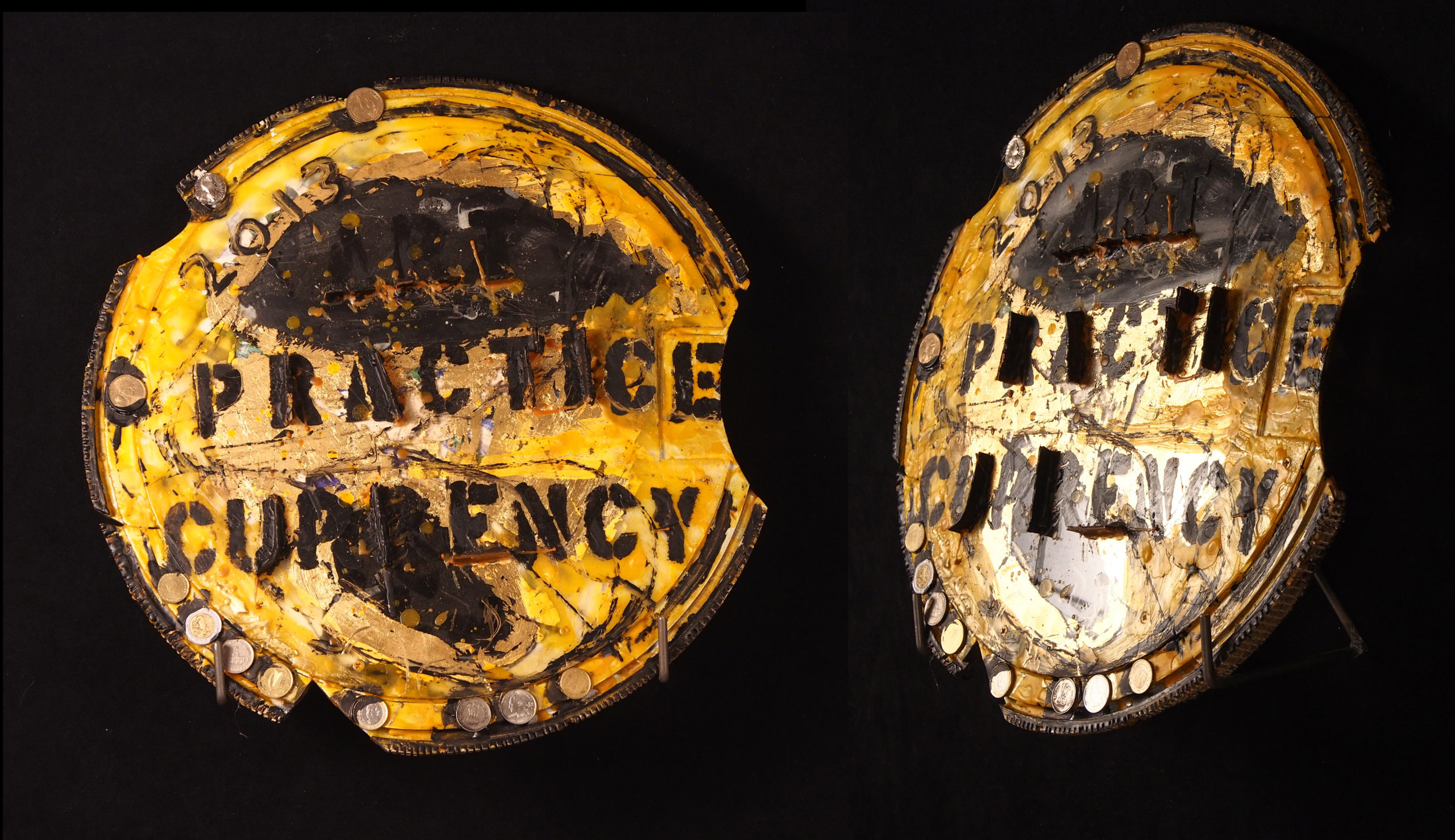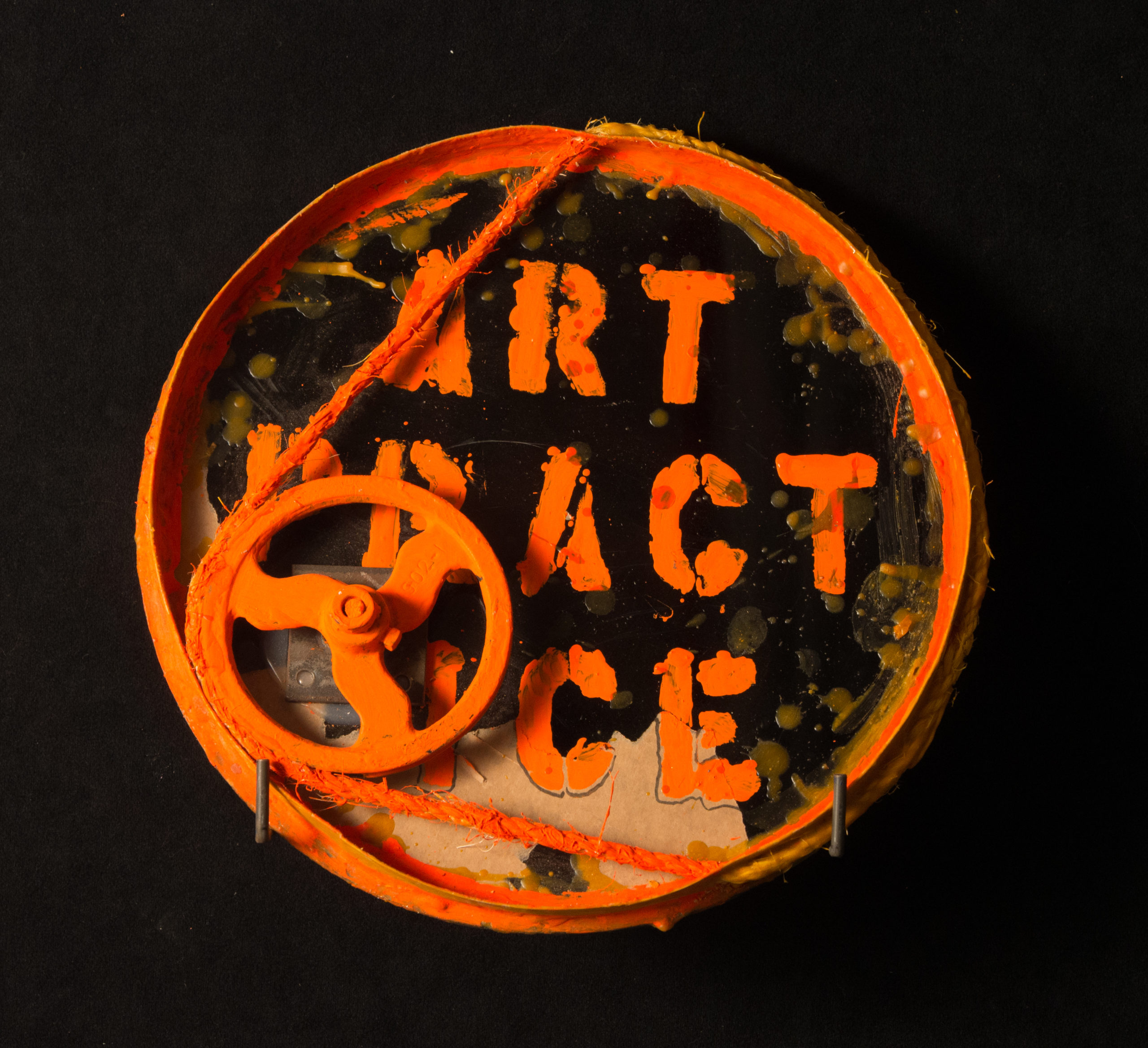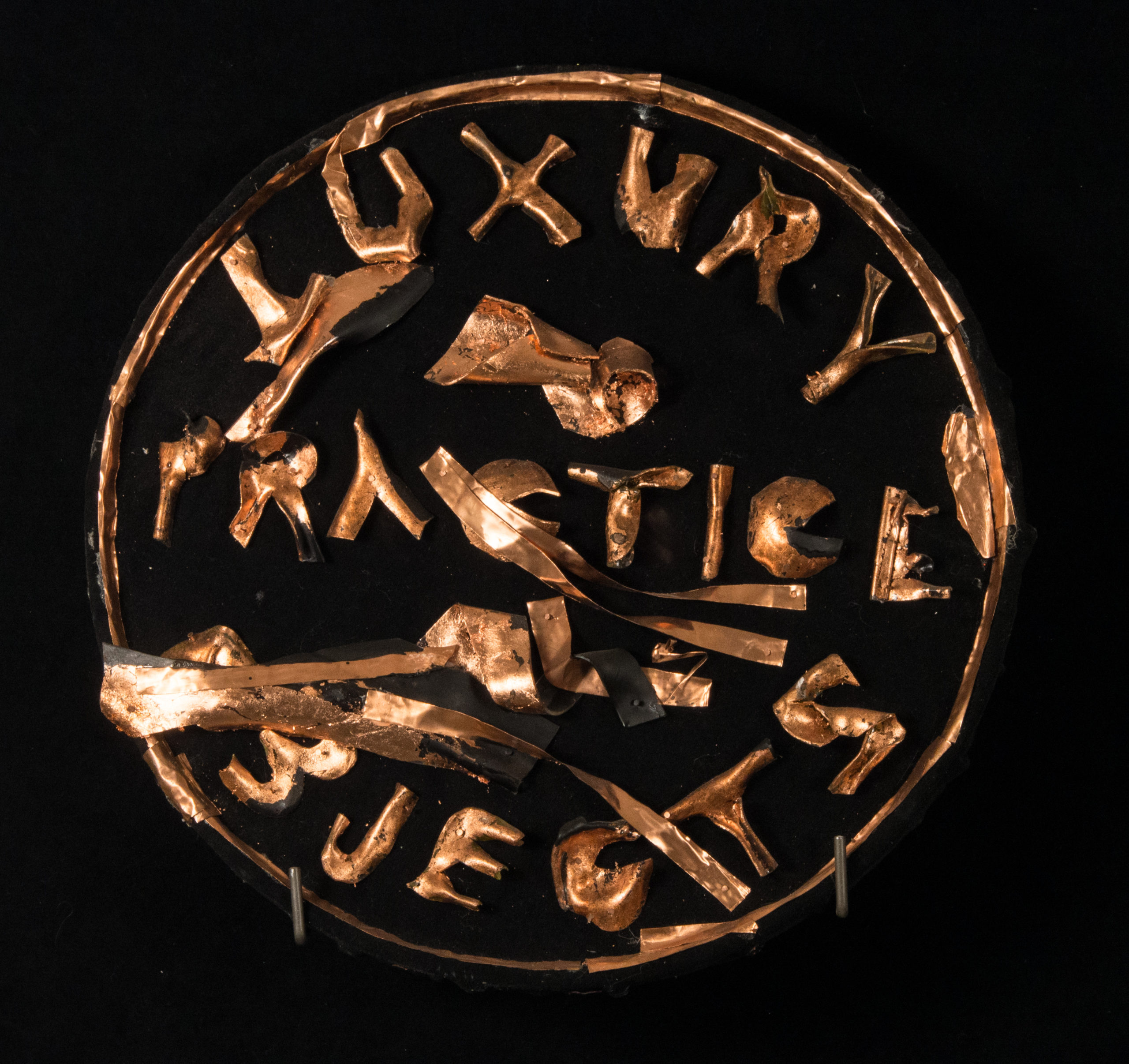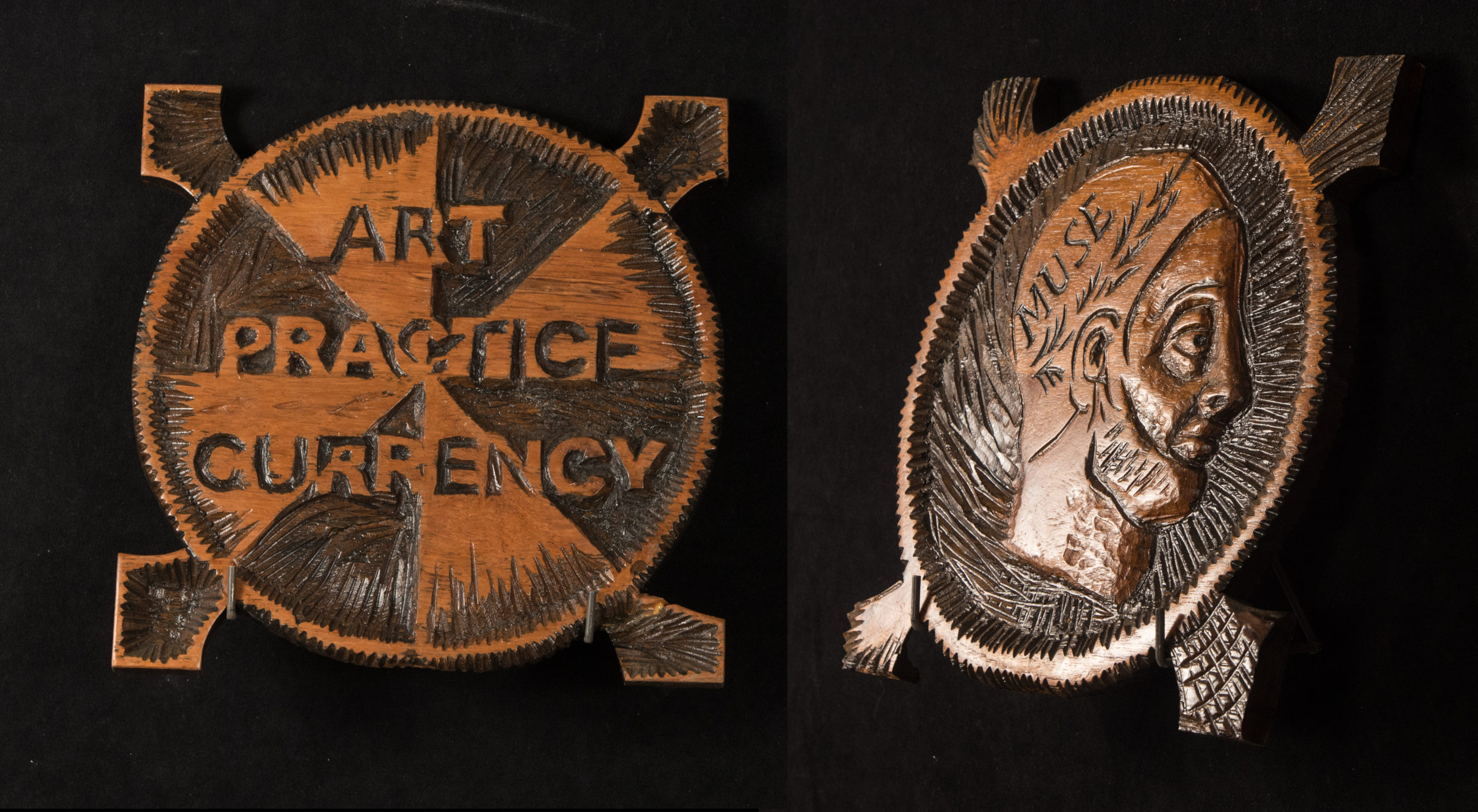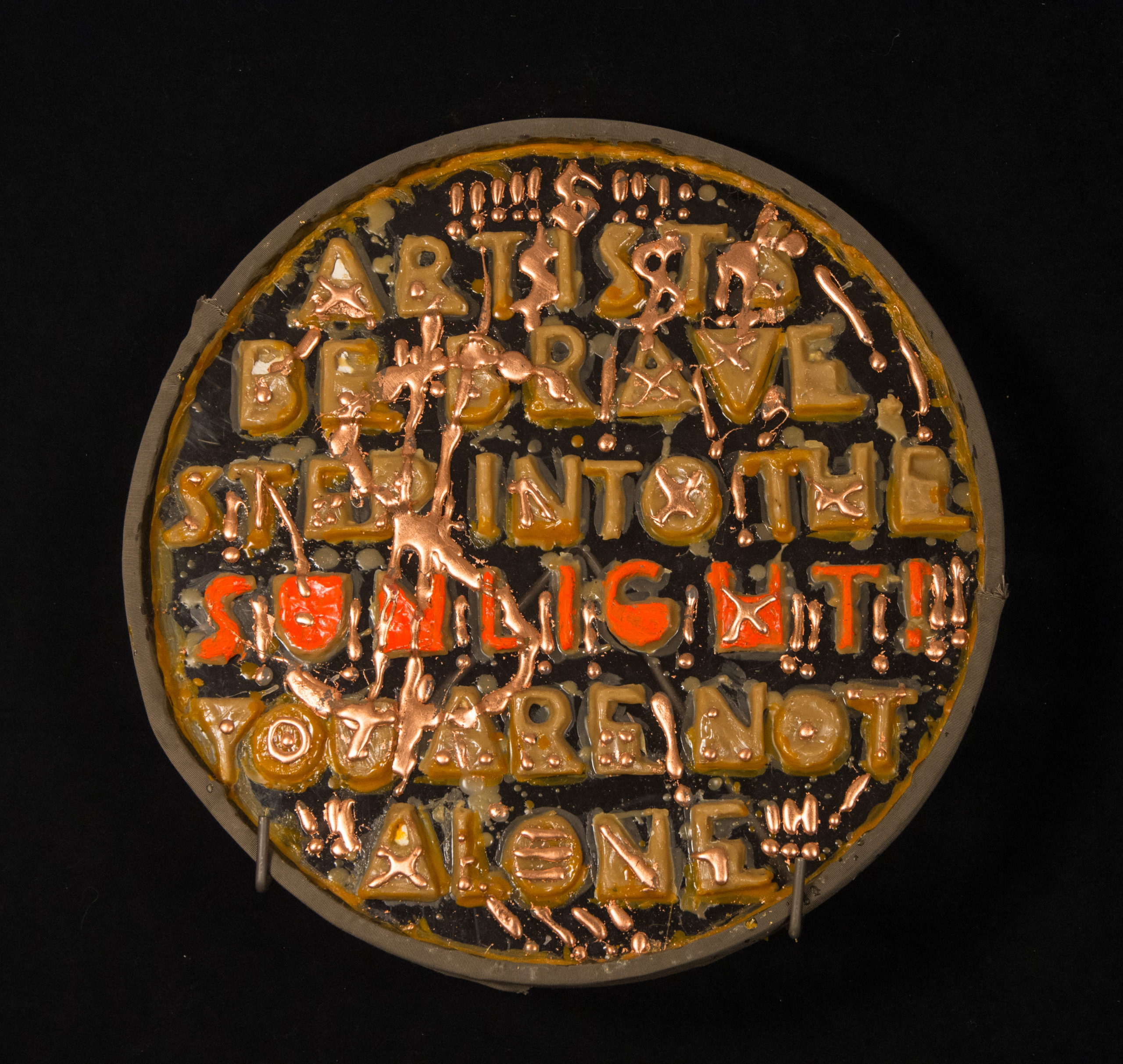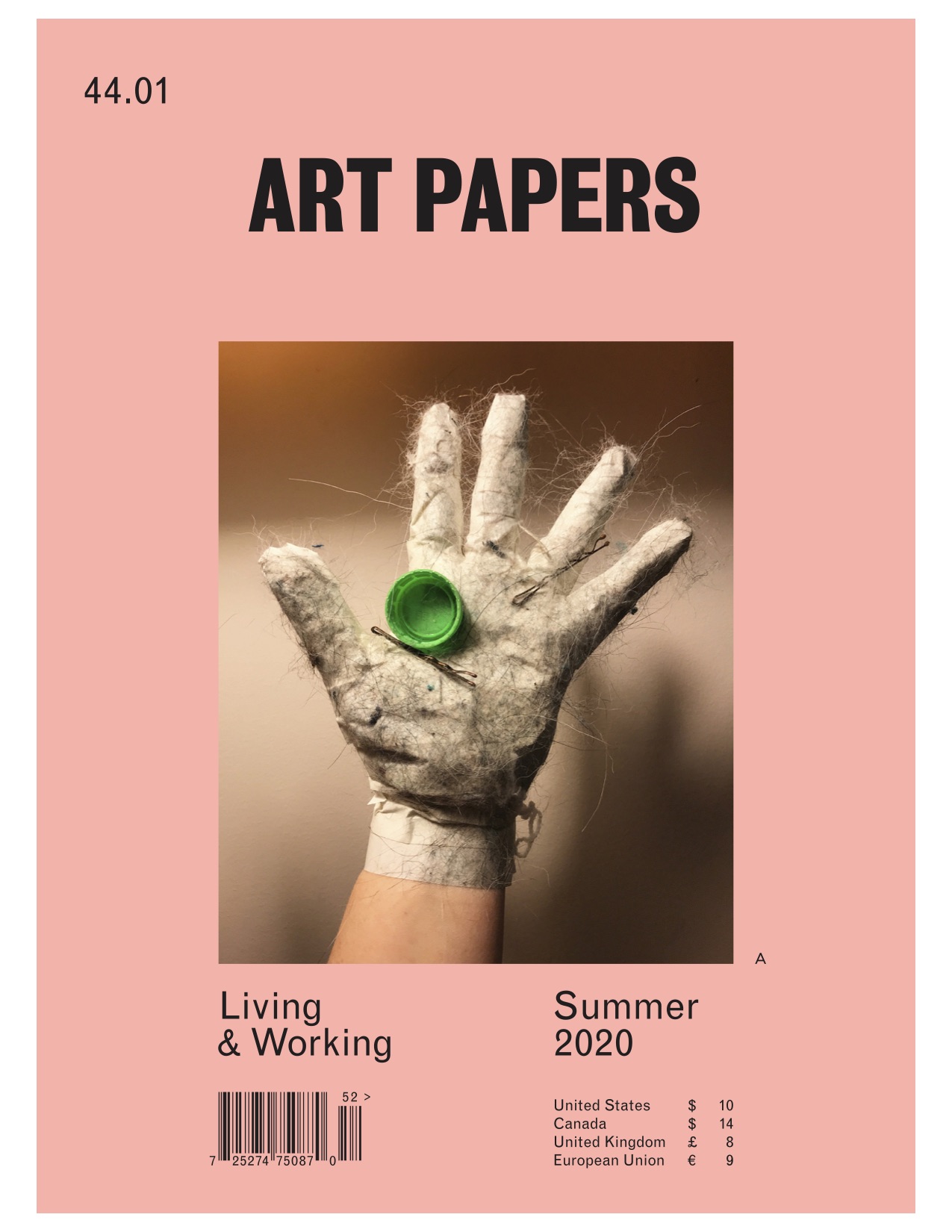Living and Working in Other Worlds
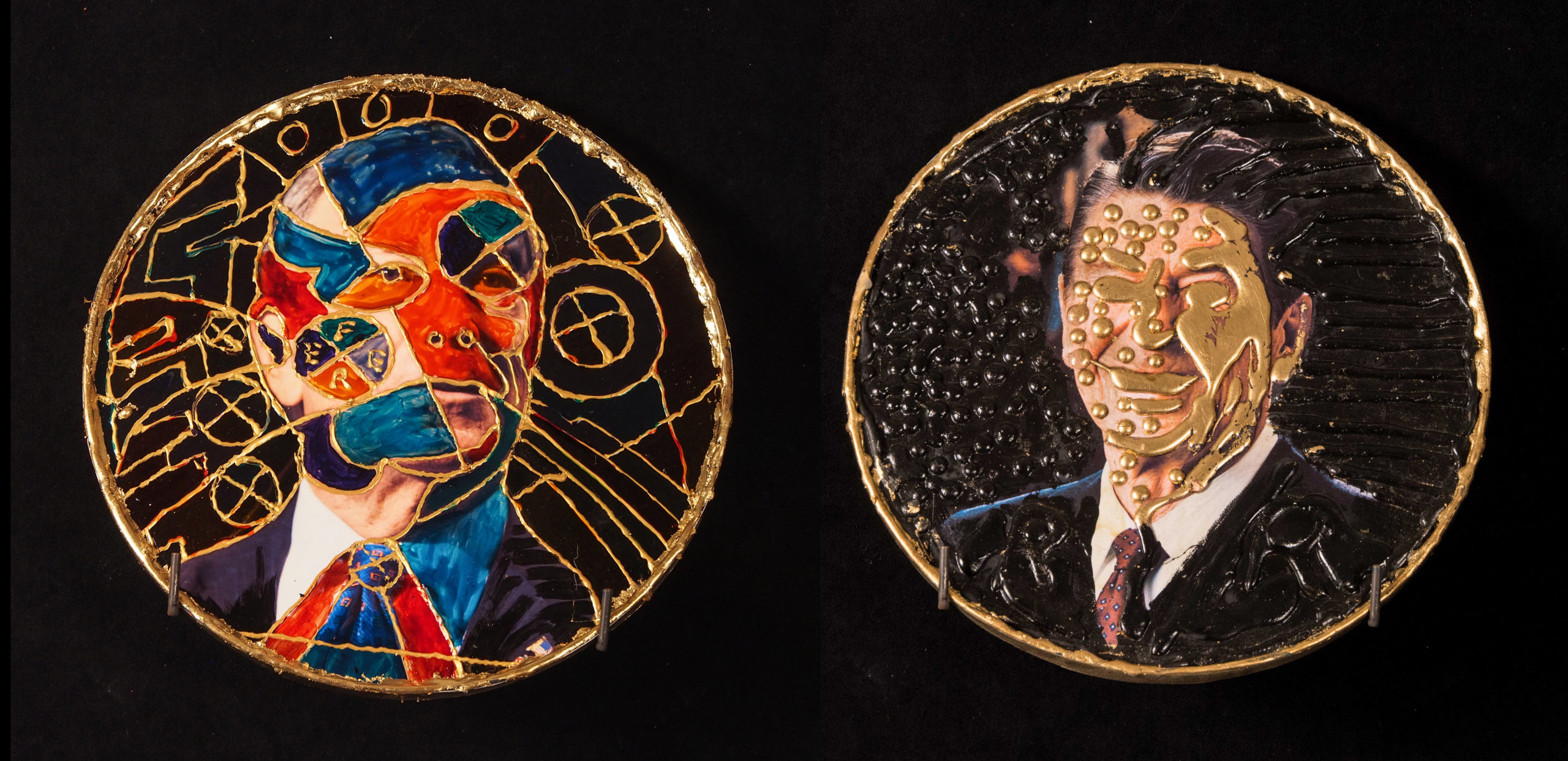
Noah Fischer, Art Practice Currency (heads), 2012-2015, mixed media, 20 inches diameter [courtesy of the artist]
Share:
The present always seems to have been inevitable. Don’t all possibilities naturally converge on every moment? Even during the unusual circumstances of global pandemic, a faint voice inside blames me for not having seen it coming, and for not being prepared. The future feels less knowable now than ever.
In a spate of recent articles, numerous authors have argued that a crisis like this one clears the canvas. Perhaps the pandemic has exposed the irredeemable deficiencies of the current order and incited an openness to something better. Such optimism is momentary relief from a time otherwise defined by grave and immediate urgencies. It is also a welcome and commendable effort to peer beyond, toward fairer and more resilient systems in which, perhaps, wealth inequality is intolerable and healthcare is a basic right.
But a crisis such as COVID offers no clean canvas. In fact, no canvas is ever truly blank. As artists and as people, we are organized by our tools. We react to conventions and zeitgeists and schooling and histories. The blank slate in front of us is a realm of severely limited possibilities, although the constraints have become so normalized that they may no longer be visible.
Under such conditions, the best an artist can be is critical—urgent, vital, demanding, sharp—first of ourselves and then of others. I do not mean to suggest that artists must always be dissatisfied. Critique is an orientation toward questioning, and, when necessary, toward celebration or agitation. It is how we reassess, rethink, make strange, make visible, and poke around the blank slate. Critique enables us to feel, then possess, and then define for ourselves the contours of the spaces within which we create. Critique is a practice of freedom. It is how we create other worlds.
Noah Fischer, Art Practice Currency (2013), 2012-2015, mixed media, 20 inches diameter [courtesy of the artist]
Philosopher Alva Noë argues in Strange Tools: Art and Human Nature that efforts “illuminating the ways we find ourselves organized” are essential to all consequential artistic practices. Artist Luis Camnitzer argues in an article for e-flux that art is not a means of production but “a form of thinking … a meta-discipline that is there to help expand the limits of other forms of thinking.” In describing artists without the capacity to “art think,” Camnitzer writes: “no matter how well some day they might render faithfully what they see, the danger is that their minds may not be able to differentiate between prepackaged, indoctrinating conventions and their own potentially challenging thoughts. They may not even realize that challenging thoughts exist.”
Art should be critical. It should make us visible to ourselves. Art should push against the edges of the world and create new realms of possibility.
But is possibility enough? I remember once admiring a large banner created by an Occupy Wall Street compatriot that read “Another World Is Possible.” While beautifully lettered, the banner’s message lacked substance, falling in line with a long history of imprecise political sloganeering that fits neatly on a pin and can be all things to all people.
To be fair, plenty of more specific proposals have been circulating in recent years, particularly those of Senator Bernie Sanders and others affiliated with the Justice Democrats in the United States. Will these proposals, if enacted, constitute enough of a shift to bring about “another world?” The artists and activists with whom I have aligned in recent years have critiqued institutions such as capitalism, white supremacy, and patriarchy to an extent that makes Sanders’ proposals appear timid. Tax the wealthy to pay for social programs? Doesn’t that make the wealthy even more indispensable?
Perhaps “another world” will never emerge. In the early 1930s, philosopher Antonio Gramsci claimed the West was mired in an interregnum, an in-between period within which “the old is dying and the new cannot be born.” Nearly a century later, this notion strikes me as relevant still. Any system premised upon never-ending growth and ever-deepening exploitation is unsustainable, but the current constellations of powers make anything else seem impossible. Within this context, “Another World Is Possible” becomes a rallying cry for people who refuse to let their political imaginations be dominated by Western isms. In a recent Financial Times article, the novelist Arundhati Roy writes that the pandemic is a “portal, a gateway between one world and the next.” The pandemic demands that we “break with the past and imagine [our] world anew.” She adds: “And in the midst of this terrible despair, it offers us a chance to rethink the doomsday machine we have built for ourselves. Nothing could be worse than a return to normality.”
More sloganeering, in my opinion. The “next world” Roy imagines is inherently her own. Lacking any specificity, she avoids the messy compromises required of actionable proposals. Furthermore, who is the “we” she invokes? Is she really suggesting that there exists today only “one world”?
Those of us working to build more equitable futures can no longer be satisfied with “Another World Is Possible”–thinking. Not only is the notion too vague, it reacts to the Western monolith with one of its own: one system to replace the other. Rather, we should seek a plurality of systems, innumerable heterotopias, worlds within worlds.
Let’s create many worlds. If one world consists of a set of institutions through which folks meet basic needs, as well as find coherent meaning and connection, then plenty of worlds already exist today. Indigenous Nations, for example, have sustained worlds over many generations. These worlds exist amid and in between and in spite of. Each must be protected and nurtured.
We Make Other Worlds With Our Bodies and Minds
I propose that if we are to truly preserve our political imaginations—if we are to replace the “doomsday machine” institutions Arundhati Roy describes with worlds better suited to living harmoniously on a finite planet—we have to invest in artists. I refer here not to people who possess expensive degrees, or those who are represented by galleries or who have portfolios filled with drawings. I mean people who, in the Camnitzerian sense, are truly capable of critical “art think.” We need art-thinkers who are also art-doers.
In a recent article, writer and curator Jillian Steinhauer writes: “We make other worlds with our bodies and minds. We paint, we dance, we sing; we bake, we sew, we build …. We turn the mess and beauty of this world into something that contains the prospect of new ones.” Yes, indeed! A better definition of art is hardly possible. But I would add “we organize” to her list of verbs. We make rules, define categories, and set standards. We institute. Organizing is fundamental. It makes intelligible our painting, dancing, and singing. It provides the stage upon which we negotiate the meanings of things.
Noah Fischer, Art Practice Currency, 2012-2015, mixed media, 20 inches diameter [courtesy of the artist]
Organizing is about power and how we choose to share it. It is about systems. It is, in a material sense, about making worlds. At a time when we have recognized the insufficiencies of current systems, we need artists—those who can engage in the reciprocal process of art thinking and art doing—to try out different rules, categories, and standards. During this global pandemic, we need artists to organize.
Plenty of artists already do so. The most common form of this practice includes unmonetized projects that rely on other arts institutions such as galleries and museums for funding and visibility. Museum of Nonhumanity. Institute of Wishful Thinking. The Atlas Group. I have personally experimented with this form through my work with Debtfair and School of Apocalypse. Such projects can produce models and be replicated elsewhere or institutionalized by larger bodies. However, despite the themes each project nominally approaches, as an organizing practice—the practice of power and the way it is shared—each deals essentially with narrative, identity, and aesthetics, issues that tend to fall within the wheelhouse of conventional art making.
Noah Fischer, Luxury Practice Object, 2012-2015, mixed media, 20 inches diameter [courtesy of the artist]
These projects are almost all short lived, in large part because they do not pay the bills. As artworks go, they can demand a tremendous amount of work, requiring many unpaid hours spent on conference calls and poring over spreadsheets. Although they can be rewarding in other ways, including materially, their almost inevitable common outcome is burnout. While they last, the very fact that they are unattached to a business plan or revenue model (apart from the occasional exhibition fee or sale) gives them space to be experimental. They can be as critical as they wish, within reason. But what happens when such a project aims toward financial sustainability, toward providing for basic needs, or perhaps even a livelihood? What happens when such a project aims to organize power by accessing and sharing money? Must such projects sacrifice criticality?
Legitimate cause for concern exists. If aiming to produce a monetizable, organizing project in the United States, an artist often chooses between two basic models. The first—the for-profit model—requires finding a solution to an existing market need or creating a new need. Meow Wolf, founded in 2008 in Santa Fe, is a standout in this category. The second—the nonprofit model—requires convincing government that you are providing a useful public service worthy of investment. Or it requires somehow persuading private individuals to give you their private money. The full scope of possibilities within each model can be broad, and they can be hybridized. Plenty of projects leverage both models but exceed them into a space called the solidarity economy, a robust network already building worlds beyond the Western monolith for decades. Elements of this network exist almost everywhere, but in the New York City area with which I am most familiar, some notable examples include the Everything Goes chain of stores operated by the longstanding Staten Island-based intentional community Ganas, for-profit member-owned and operated food cooperatives such as the Park Slope Food Coop, and nonprofit banking institutions including the Lower East Side Peoples’ Federal Credit Union.
The American Model
Noah Fischer, Art Practice Currency (heads), 2012-2015, mixed media, 20 inches diameter [courtesy of the artist]
If we are to create a plurality of worlds guided by reverence and mutuality, it is particularly important for art-thinkers to organize new cultural institutions. In 1973, artist Joseph Beuys wrote that “every human being is an artist” who, “from his state of freedom,” contributes to a “total art work of the future social order.” More accurate would be the claim that every human being can be an artist when choosing to exercise critique in the creation or reproduction of social orders. Nevertheless, no matter how broadly we seek to define art on paper, the definition of art will always be more powerfully affected by those who organize within the formal institutional spaces of art, the glass-and-steel vaults, temples, sanctuaries, and academies. By formalizing and institutionalizing the conventions of creative practices, the ways cultural institutions are organized circumscribe the space within which, as Steinhauer puts it, we “make other worlds with our bodies and minds.”
Cultural institutions tend to organize themselves as nonprofits because they provide a public service. The United States somehow sustains 115,000 arts nonprofits, but it does so with less and less involvement from public funds. The National Endowment for the Arts was allocated $162 million in 2020, the same amount it received in 1984. Adjusted for inflation it amounts to a 60% drop in funding. Overall, federal, state, and local public funding for the arts in 2019 equaled a per capita investment of a mere $4.19. Absent public support, the private sector has had to step up to fill in the gaps. Arts and culture are consistently among the top funding priorities of private foundations, along with health, education, community and economic development, and human services. In 2017, private foundations awarded a total of $2.8 billion in grant funding to arts organizations, compared to a total of $1.4 billion of total government funding. This number excludes corporate contributions and donations made by individuals, the latter of which actually accounts for the lion’s share of private arts funding in the US.
In Europe, they call this emphasis on private funding the American Model. Europeans, by contrast, enjoy a great deal more government funding for the arts, so much so that arts organizations cannot function without it. However, public support for the arts in Europe is diminishing. Politicians infatuated with austerity argue that the privatized American Model enables arts organizations to function more freely by diversifying their sources of support.
Perhaps this approach is reasonable. Perhaps a crazy, experimental idea would more easily find backing within a larger and more diverse group of private donors than it would within a single government agency. Proponents of privatization argue that the American Model is more agile and saves artists from having to fit politically predetermined criteria. What the theory does not consider is that the American Model exists within a radically unequal society, where the ongoing centralization of wealth empowers an ever smaller and evermore homogeneous class (in terms of taste and political affiliation) with the distinct honor of identifying the few worthy causes among the many, which are not so fortunate. For an arts nonprofit to survive in this environment, it must court members of this class by adopting their values and standards, which influences not only best business practices but also overall voice, tone, and look. Private funding in an unequal society thus has all the trappings of a centralized system but none of the accountability.
Noah Fischer, Art Practice Currency (woodmuse), 2012-2015, mixed media, 20 inches diameter [courtesy of the artist]
The American Model is shortsighted. Grant periods are typically one year, so nonprofits compete for the same grants year in and year out. These grants tend to offer limited support for specific projects or exhibitions rather than meet general operating needs. For the latter, arts organizations turn to individual contributions from a narrowing community of major donor prospects. The results are tangible. Rather than focusing staff time on fulfilling their missions, arts nonprofits tend to obsess over annual galas, VIP openings, and special lounges to infuse the arts experience with a sense of exclusivity and luxury for their donors. As Andy Horwitz puts it in an extensively researched 2016 article about the National Endowment for the Arts in The Atlantic, “large, mainstream arts institutions, founded to serve the public good and assigned non-profit status to do so, have come to resemble exclusive country clubs. Meanwhile, outside their walls, a dynamic new generation of artists, and the diverse communities where they live and work, are being systematically denied access to resources and cultural legitimation.”
The “donor-centered” approach affects not just how arts institutions are funded but also what gets shown to the public. Not long ago, the head curator at a major museum in New York City revealed to me that new exhibition ideas do not move forward until the curatorial team consults with museum trustees—real-estate magnates, heirs to fortunes, titans of industry, and the like—to ensure there is sufficient interest and funding. In other words, this major standard-setting museum of art does not empower its visionary curators with free rein to determine the artists, artworks, and themes that are important to spotlight today. Trustees, with no arts credentials other than expensive private collections and common philanthropic interests, hold veto power over who and what gets seen. From a business standpoint, centering trustees makes sense. Why proceed with an exhibition you cannot fund? From an arts perspective, this condition represents a profound breach of the public trust. Art becomes important only when it can mobilize capital.
Complex systems can often produce paradoxical effects. The American Model of private funding for arts nonprofits, which has been justified by proponents in the name of decentralization, freedom, and choice, has instead created a sector that is more homogeneous and less publicly accountable. Smaller and “start-up” arts organizations, especially ones serving communities of color and rural communities, have become less financially viable and are thus structurally discouraged. The American Model reifies the wealth and power of the wealthiest and most powerful organizations.
We Need Government Funding for the Arts
Noah Fischer, Manifesto Currency, 2012-2015 [courtesy of the artist]
I have argued that organizing power, or institution building, is an essential artistic practice in that it deliberately tinkers with the conditions within which people interact and meaning is created. Institution-building is a practice that is exceedingly important to encourage at a time when so many existing “doomsday machine” institutions are unable to meet the challenge of providing for equitable and sustainable futures. Rather than a single global order, perhaps we face a period in which multiple systems flourish side by side, a resilient and inclusive plurality of worlds to support many ways of knowing and being. We must provide artists—people who “art-think”—with a nurturing environment within which to exercise critique in the creation of new social orders. And to do so, we need our government to fund the arts.
The idea that centralized public funding would probably better support experimentation in institution-building than would private funding may seem a strange argument to make at a time when public trust in our governing institutions is at a historical low. Why would you want a small group of politically sensitive bureaucrats to make decisions about which organizations live or die, which exhibitions proceed, and who is appointed to top roles? Indeed, government funding for arts has been weaponized in recent years against opponents of right wing causes in countries such as Hungary and Poland, which are experiencing a swift rightward shift. Nevertheless, public arts funding in the United States has an impressive record of supporting valuable cultural programs in communities typically lacking in access. Government grant periods can also extend into a longer time frame and provide multiyear financial stability. Like anything else, such practices can shift with changes in policy, but at least with government we can advocate on our own behalf. At least those bureaucrats are nominally accountable to the people. A single-payer system for the arts might result in decisions I do not like. But unlike today, the process could potentially be open to my input. I propose that the world-building attributes of art making are better served by funding models that intentionally define the collectivities from which the arts derive material support.
The COVID-19 pandemic is less a portal and more a mirror. It has exposed for us just how fragile our institutions are, and how incapable they are likely to be when facing the far more volatile and prolonged impacts of climate crisis and mass extinction. The killings of unarmed African Americans have underscored the incompatibility of our law enforcement and carceral institutions with visions of a just society. Now is our time to inspire a new era of robust government support for the arts. If we succeed, we might just provide fertile ground for artists to paint, dance, sing, bake, sew, build, and organize more caring worlds for us to live in.
***
This feature originally appeared in print in ART PAPERS Summer 2020 // Living & Working.
Tal Beery makes art, curates exhibitions, and writes about the roles and responsibilities of cultural institutions during our time of epochal change. His latest curatorial project, Owning Earth, opens September 2020. Beery is chief development officer of the Hurleyville Performing Arts Centre and lives in the Catskill Mountains of New York state.
Noah Fischer is a Brooklyn-based artist who connects interdisciplinary art practice with social movements. His work has been seen, with and without invitation, at the Guggenheim Museum, The Museum of Modern Art, The Brooklyn Museum, and The ZKM, as well as in the 56th Venice Biennale, 7th Berlin Biennale, the 2017 Whitney Biennial, and elsewhere. Fischer is a member of the art collective Occupy Museums. He has taught at Parsons, Kenyon College, Rhode Island School of Design, Pratt Institute, and Columbia.
